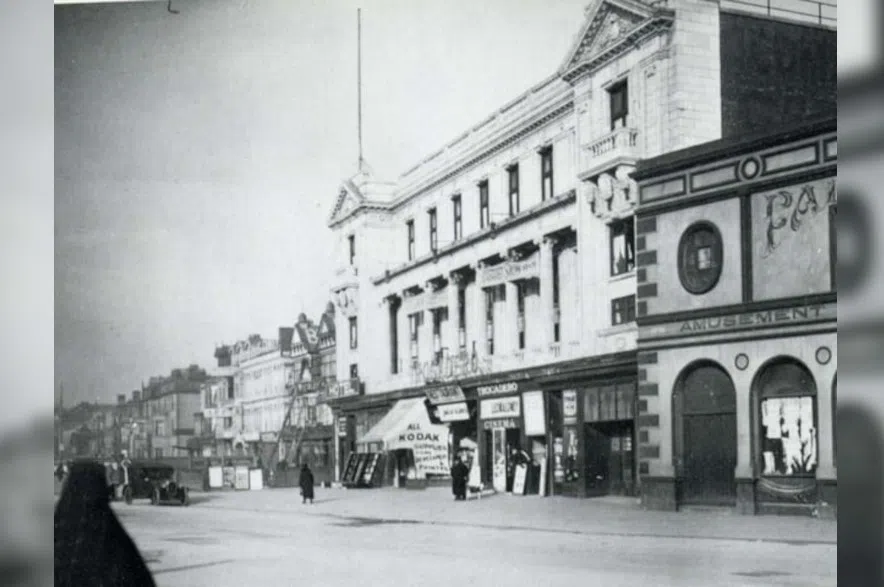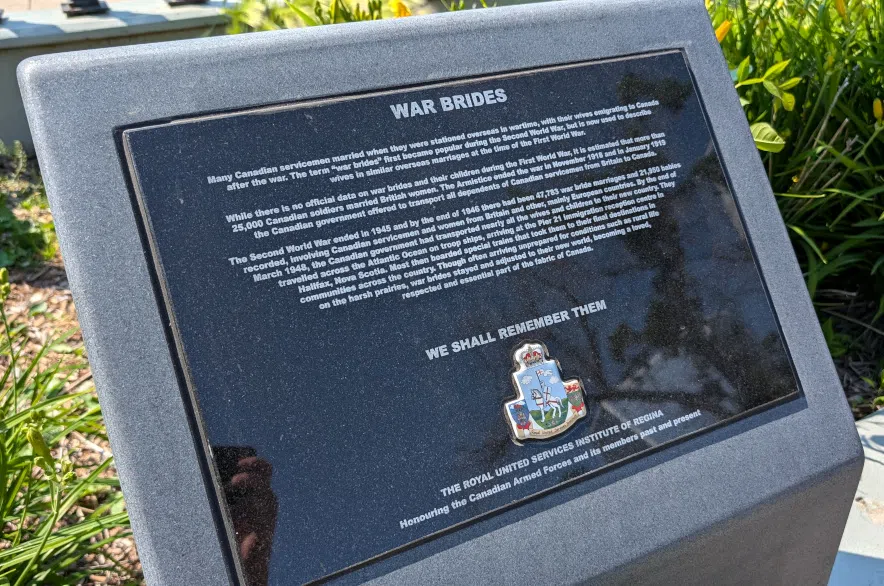When she left her home in 1946 to follow her Canadian soldier back to the Saskatchewan prairies, it was all just one big adventure for Jean Fells.
She was one of tens of thousands of war brides who came to Canada during and after the two world wars.
On Thursday, a pedestal was unveiled at the Regina Cenotaph to recognize these women and their contributions to Canada.
Bernice Fells and her sister Elaine Heney were there on behalf of their mother, Jean. Elaine said her parents met at Fairyland — an amusement park in Blackpool, England.
“There were three soldiers who were on leave and they had wanted to go to Ireland but they needed either civilian clothes or a passport and they had neither, so they threw a dart at a map and Blackpool was where they went,” explained Bernice.
Her mother wasn’t quite 16 at the time and was there with her sister. The soldiers asked the girls what there was to do for fun, and Bernice said it went from there.
“Dad would go there on leave, to outside Leeds where mum lived, and they married on November 3, 1945,” she explained.
The pair honeymooned in London then Bernice said her father was sent back home almost immediately on the Queen Elizabeth. Her mother came the following year at the tender age of 19.
Even though she would meet her in-laws for the first time when she arrived, Bernice said Jean already knew them a bit and they had been good to her.
“They were so severely rationed (in England) that they (the in-laws) sent all the ingredients for wedding cake, and they sent the material for various things,” said Bernice.
Many war brides left European cities for the much less advanced prairies.
Lynn Martin, president of the Canadian War Brides and Families, was at the pedestal unveiling. Her mother was also a war bride.
“My mother came in April — her dad was a watchmaker, so they had all the fittings and proper indoor heating, et cetera (at home) — to arrive in Davidson, Saskatchewan. My grandparents met her with a horse and sled, took her to a farm with outdoor plumbing, a booker stove for heating on the farm, and no power — not until 1956,” said Martin.
Many of the war brides were veterans themselves and they brought both their skills and interests with them. Martin said they got involved in their communities. The new cenotaph pedestal recognizes that.
“This pedestal opens a whole new world of history,” said Martin.
She couldn’t say whether any other province has such a pedestal but did say it now makes Saskatchewan a leader.
A new pedestal commemorating war brides now sits beside the Regina Cenotaph. Jul. 11, 2024 (Lisa Schick/980 CJME)
The provincial government’s Status of Women Office provided the funds for the pedestal. Laura Ross is the minister responsible, she said the pedestal celebrates women who really helped build the province.
“When the committee came and said ‘We need a little help with funds to be able to put the monument up.’ I was pleased to be able to sit down with the executive from the Status of Women office and say ‘okay, this has to be done,’” said Ross.
Martin said 80 per cent of the war brides came to Saskatchewan and Alberta because they married farmers. But there are only a few left in Saskatchewan, three to Martin’s knowledge. The loss of these women makes recognition of their stories all the more significant, according to Martin.
“This is why we need to have this and this is why we need to continue with the war brides and the families,” she said.
Martin said it is now up to the families to take over and keep their history present.
Saskatchewan lost two of its war brides in just the past month, including Jean Fells — Bernice and Elaine’s mother.
Bernice said the war brides as a group was really important to her mother. At the first big gathering, Bernice said she saw an ad in the paper and told her mother.
“Well, it was like ‘get the whole crew together,’” she explained, saying there were a lot of war brides around Davidson, Bladworth and Kenaston.
“(It was) friends your own age who’ve experienced the same things that you’ve experienced, you know. Family is good, but that network of friends was very important,” she said.













